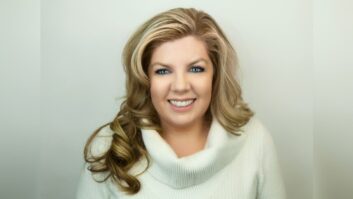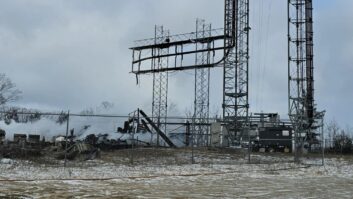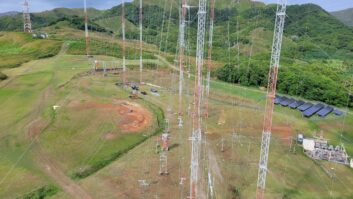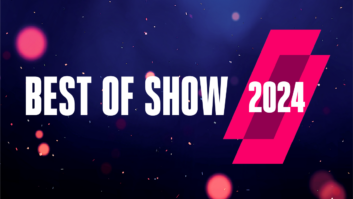(click thumbnail)Fig. 1: An umbrella was pressed into service to keep the high-voltage vault dry.Fall is a wet time of year, and you may have been challenged recently with water entering your transmitter site. But never like this!
I’m always amazed at the ingenuity of broadcast engineers. That’s why this is such a great industry and career.
In the case of our figure, the roof of a leased transmitter building was leaking, and getting progressively worse with all the rain. The landlord was dragging his feet to get the problem solved, and the chief had to keep the station on the air. Of course, the biggest leak took place over the RCA BTF20E’s high-voltage vault.
The summertime beach umbrella to the rescue! Sure it looks crazy. But it worked.

. . .
Our Sept. 8 column suggesting the use of a piece of rubber tire inner tube to protect locks comes with a caveat.
(click thumbnail)Fig. 2: Transmitter exhaust hoods provide shelter for nesting bees. Inspect with a can of wasp spray.
Noel Richardson, vice president of engineering for West Virginia Radio Corp., saw the familiar ice shield and wrote that it does an excellent job of protecting the lock against the elements, especially during icy winters in West Virginia.
However, Noel has a word of caution. The inner tube sleeve makes a great home for wasps to build a nest. Within three days, Noel was back at this site and moved the rubber sleeve to unlock the lock. Three wasps flew out, and yes, they had built a nest there.
Noel adds that gateposts are another good hiding places for these little terrors.
Noel and his engineers keep a can of wasp spray inside the car, along with a can of Off! or similar brand insect repellent. Ticks, mosquitoes and spiders are plentiful around transmitter sites.
Fall is a good time to give fence posts, eaves, ATUs and even the rubber ice sleeve a spritz of wasp spray. As these insects sense the cooler temperatures, they will search for sources of warmth; transmitter exhaust hoods and transmitter rooms are great. A good reason to keep things sealed. That includes the rubber seal at the door threshold.

. . .
RF is to be respected. Fig. 3 will drive that point home. A transfer switch has been switched “hot” – the transmitter does not shut down while the switch moves – and the results are seen here.
If you don’t have a spare switch in your group, fabricate a “U-link” to patch around the switch while it is removed and repaired. A “U-link” can be as simple as a short piece of line and a couple of unflanged elbows to form the “U.” Don’t forget the field flanges to mate to the EIA terminations.
(click thumbnail)Fig. 3: Operating a transfer switch while under full transmitter power is not a forgiving event.
At some sites, there is enough play in the transmission line that the ports “transmitter out” and “antenna in” can be married together; but don’t force anything. Having a “U-link” sitting on the shelf is preferable insurance. Even better is to make sure the transmitter interlocks are wired through the switch so it’s impossible to switch when the transmitter is on the air.

. . .
Former Infinity DC Chief Mike Friedman suggests you check out the iRiver MP3 device he just purchased at Circuit City for $129.99. The unit accepts external line-level audio via a 1/8-inch jack. The device also packs an FM tuner, which has good reception considering the device, and convenient size. The tuner has 20 FM presets, and it records FM broadcasts.
(click thumbnail)Fig. 4: Display of the iRiver MP3 unit, which records FM broadcasts.
As with all MP3 players, it interfaces with your computer. Pick one up for your GM or PD; jocks and sales staff will want their own, too. Don’t forget your holiday list, too.
While this concept is nothing new, it’s the smallest, cheapest and most versatile unit Mike has seen for anyone wanting to capture the FM airwaves on the go. The display is shown in Fig. 4. The only drawback is that the recorder will only record as good as the received signal. Distant FM signals will record noisy.
Bring it up at a manger’s meeting. If you buy the first one for yourself, bring it along – and take orders. Demonstrating something that can help the PD monitor competition and the sales folks skim competitors for spots just drives home the point that you are a team player.
I’ve known these discount houses to offer a better price on multiple purchases. Get your order together and talk to the manager.
Thanks, Mike, for a great idea to not only get the job done, but to help promote engineering as a new technology leader. Mike Friedman can be reached at [email protected].

. . .
I’ll be the first to admit some wariness with regard to ordering over the Internet. However, I’ve seen the results of many engineers’ searches, and you can get some great buys.
This site looks promising, though I can’t make any recommendations. Taiwan Connector manufactures a variety of small RF connectors, plugs and cable assemblies. They want a minimum quantity of 1,000 pieces; but several engineers – or a group – could make that quantity disappear quickly. Type “N” crimp connectors for 50 cents, bnc plugs for less than a quarter. The company is a division of Fortunet Co., and its Web site www.taiwanconnector.com , or e-mail to [email protected].
Submissions for this column are encouraged, and qualify for SBE recertification credit.












